2003 Oldsmobile Alero oil
[x] Cancel search: oilPage 254 of 354
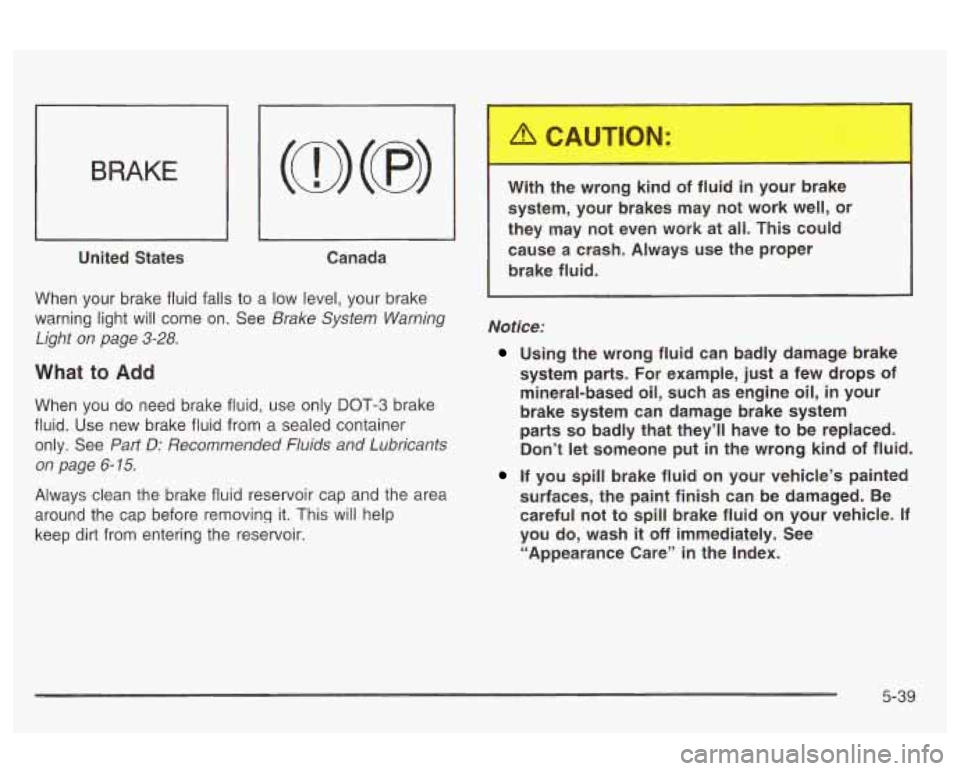
BRAKE
I I
United States
I I
Canada
When your brake fluid falls
to a low level, your brake
warning light will come on. See
Brake System Warning
Light on page
3-28.
What to Add
When you do need brake fluid, use only DOT-3 brake
fluid. Use new brake fluid from a sealed container
only. See
Part D: Recommended Fluids and Lubricants
on page
6- 15.
Always clean the brake fluid reservoir cap and the area
around the cap before removing it.
This will help
keep dirt from entering the reservoir.
\. ._h the wrong kinc~ luid in you1 re
system, your brakes may not work well, or
they may not even work at all.
This could
cause a crash. Always use the proper
brake fluid.
Notice:
Using the wrong fluid can badly damage brake
system parts. For example, just a few drops
of
mineral-based oil, such as engine oil, in your
brake system can damage brake system
parts
so badly that they’ll have to be replaced.
Don’t let someone put in the wrong kind of fluid.
If you spill brake fluid on your vehicle’s painted
surfaces, the paint finish can be damaged. Be careful not to spill brake fluid on your vehicle. If
you do, wash
it off immediately. See
“Appearance Care’’ in the Index.
5-39
Page 288 of 354
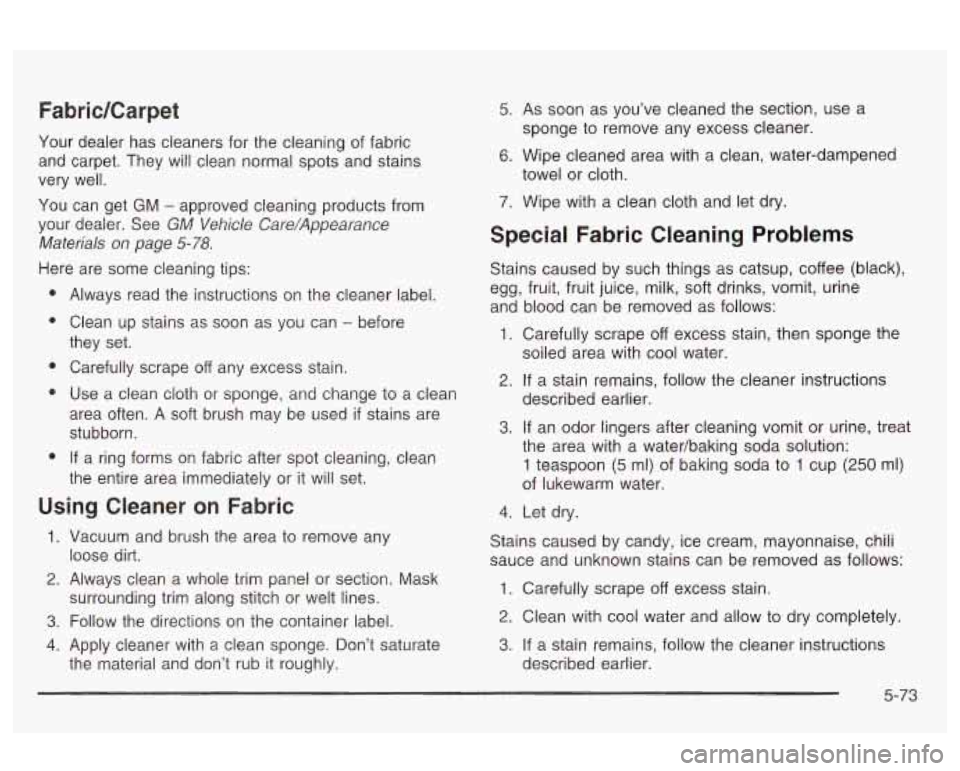
FabricKarpet
Your dealer has cleaners for the cleaning of fabric
and carpet. They will clean normal spots and stains
very well.
You can get GM
- approved cleaning products from
your dealer. See
GM Vehicle Care/Appearance
Materials
on page 5-78.
Here are some cleaning tips:
a
a
-.
Always read the instructions on the cleaner label.
Clean up stains as soon as you can
- before
they set.
Carefully scrape
off any excess stain.
Use
a dean cioth or sponge, and change io a cieari
area often. A soft brush may be used if stains are
stubborn.
If a ring forms on fabric after spot cleaning, clean
the entire area immediately or it will set.
Using Cleaner on Fabric
1. Vacuum and brush the area to remove any
loose dirt.
2. Always clean a whole trim panel or section. Mask
surrounding trim along stitch or welt lines.
3. Follow the directions on the container label.
4. Apply cleaner with a clean sponge. Don’t saturate
the material and don’t rub it roughly.
5. As soon as you’ve cleaned the section, use a
6. Wipe cleaned area with a clean, water-dampened
7. Wipe with a clean cloth and let dry.
sponge
to remove any excess
cleaner.
towel or cloth.
Special Fabric Cleaning Problems
Stains caused by such things as catsup, coffee (black),
egg, fruit, fruit juice, milk, soft drinks, vomit, urine
and blood can be removed as follows:
1. Carefully scrape off excess stain, then sponge the
2. If a stain remains, follow the cleaner instructions
soiled
area with cool water.
described earlier.
3. If an odor lingers after cleaning vomit or urine, treat
the area with a watedbaking soda solution:
1 teaspoon (5 ml) of baking soda to 1 cup (250 ml)
of lukewarm water.
4. Let dry.
Stains caused by candy, ice cream, mayonnaise, chili
sauce and unknown stains can be removed as follows:
1. Carefully scrape off excess stain.
2. Clean with cool water and allow to dry completely.
3. If a stain remains, follow the cleaner instructions
described earlier.
5-73
Page 289 of 354

Vinyl
Use warm water and a clean cloth.
0 Rub with a clean, damp cloth to remove dirt. You
may have to do this more than once.
Things like tar, asphalt and shoe polish will stain if
you don’t get them off quickly. Use a clean cloth
and vinyl/leather cleaner. See your dealer for
this product.
Leather
Use a soft cloth with lukewarm water and a mild soap or
saddle soap and wipe dry with a soft cloth. Then, let
the leather dry naturally.
Do not use heat to dry.
For stubborn stains, use a leather cleaner. See your
dealer for this product.
Never use oils, varnishes, solvent-based or abrasive
cleaners, furniture polish or shoe polish on leather.
Soiled or stained leather should be cleaned
immediately. If dirt is allowed
to work into the finish,
it can harm the leather.
Top of the Instrument Panel
Use only mild soap and water to clean the top surfaces
of the instrument panel. Sprays containing silicones
or waxes may cause annoying reflections in the
windshield and even make it difficult to see through the
windshield under certain conditions.
Interior Plastic Components
Use only a mild soap and water solution on a soft cloth
or sponge. Commercial cleaners may affect the
surface finish.
Glass Surfaces
Glass should be cleaned often. GM Glass Cleaner or a
liquid household glass cleaner will remove normal
tobacco smoke and dust films on interior glass. See
GM
Vehicle Care/Appearance Materials on page
5-78.
Notice: Don’t use abrasive cleaners on glass,
because they may cause scratches. Avoid placing
decals on the inside rear window, since they
may have to be scraped
off later. If abrasive cleaners
are used on the inside
of the rear window, an
electric defogger element may be damaged. Any
temporary license should not be attached across the
defogger grid.
5-74
Page 291 of 354

Cleaning Exterior Lamps/Lenses
Use only lukewarm or cold water, a soft cloth and a car
washing soap to clean exterior lamps and lenses.
Follow instructions under “Washing Your Vehicle.”
Finish Care
Occasional waxing or mild polishing of your vehicle by
hand may be necessary to remove residue from the
paint finish. You can get GM-approved cleaning products
from your dealer. See
GM Vehicle Care/Appearance
Materials
on page 5-78.
Your vehicle has a “basecoatklearcoat” paint finish. The
clearcoat gives more depth and gloss to the colored
basecoat. Always use waxes and polishes that are
non-abrasive and made for a basecoatklearcoat paint
finish.
Notice: Machine compounding or aggressive
polishing on a basecoatklearcoat paint finish may
dull the finish or leave swirl marks.
Foreign materials such as calcium chloride and other
salts, ice melting agents, road oil and tar, tree sap, bird
droppings, chemicals from industrial chimneys, etc.,
can damage your vehicle’s finish
if they remain
on painted surfaces. Wash the vehicle
as soon as
possible.
If necessary, use non-abrasive cleaners that
are marked safe for painted surfaces to remove
foreign matter. Exterior painted
surfaces are subject to aging, weather
and chemical fallout that can take their toll over a
period of years. You can help to keep the paint finish
looking new by keeping your vehicle garaged or covered
whenever possible.
Windshield and Wiper Blades
If the windshield is not clear after using the windshield
washer, or
if the wiper blade chatters when running,
wax, sap or other material may be on the blade or
windshield.
Clean the outside of the windshield with a full-strength
glass cleaning liquid. The windshield is clean if beads do
not form when you rinse it with water.
Grime from the windshield will stick to the wiper blades
and affect their performance. Clean the blade by
wiping vigorously with a cloth soaked in full-strength
windshield washer solvent. Then rinse the blade
with water.
Check the wiper blades and clean them as necessary;
replace blades that look worn.
5-76
Page 293 of 354
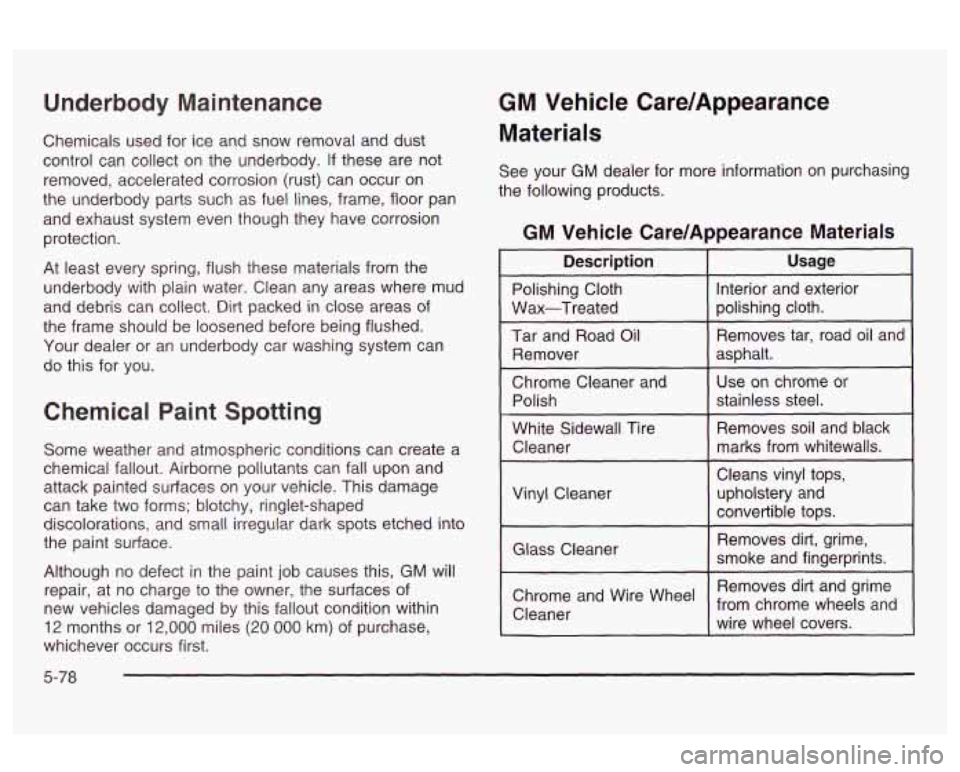
Underbody Maintenance
Chemicals used for ice and snow removal and dust
control can collect on the underbody. If these are not
removed, accelerated corrosion (rust) can occur on
the underbody parts such as fuel lines, frame, floor pan
and exhaust system even though they have corrosion
protection.
At least every spring, flush these materials from the
underbody with plain water. Clean any areas where mud
and debris can collect.
Dirt packed in close areas of
the frame should be loosened before being flushed.
Your dealer or an underbody car washing system can
do this for you.
Chemical Paint Spotting
Some weather and atmospheric conditions can create a
chemical fallout. Airborne pollutants can fall upon and
attack painted surfaces on your vehicle. This damage
can take two forms; blotchy, ringlet-shaped
discolorations, and small irregular dark spots etched into
the paint surface.
Although no defect in the paint job causes this,
GM will
repair, at no charge to the owner, the surfaces of
new vehicles damaged by this fallout condition within
12 months or 12,000 miles (20 000 km) of purchase,
whichever occurs first.
GM Vehicle Care/Appearance
Materials
See your GM dealer for more information on purchasing
the following products.
GM Vehicle Care/Appearance Materials
Description Usage
Polishing Cloth
polishing cloth.
Wax-Treated Interior
and exterior
~ ~ ~ ~~~
Removes tar, road oil and
Chrome Cleaner and Use on
chrome or
Polish stainless steel.
I
White Sidewall Tire Removes soil and black
Cleaner marks from whitewalls.
Vinyl Cleaner Cleans vinyl tops,
upholstery and
convertible tops.
1 Glass Cleaner I
Removes dirt, grime,
smoke and fingerprints.
Chrome and Wire Wheel from chrome wheels and
Cleaner Removes dirt and grime
wire wheel covers.
5-78
Page 301 of 354
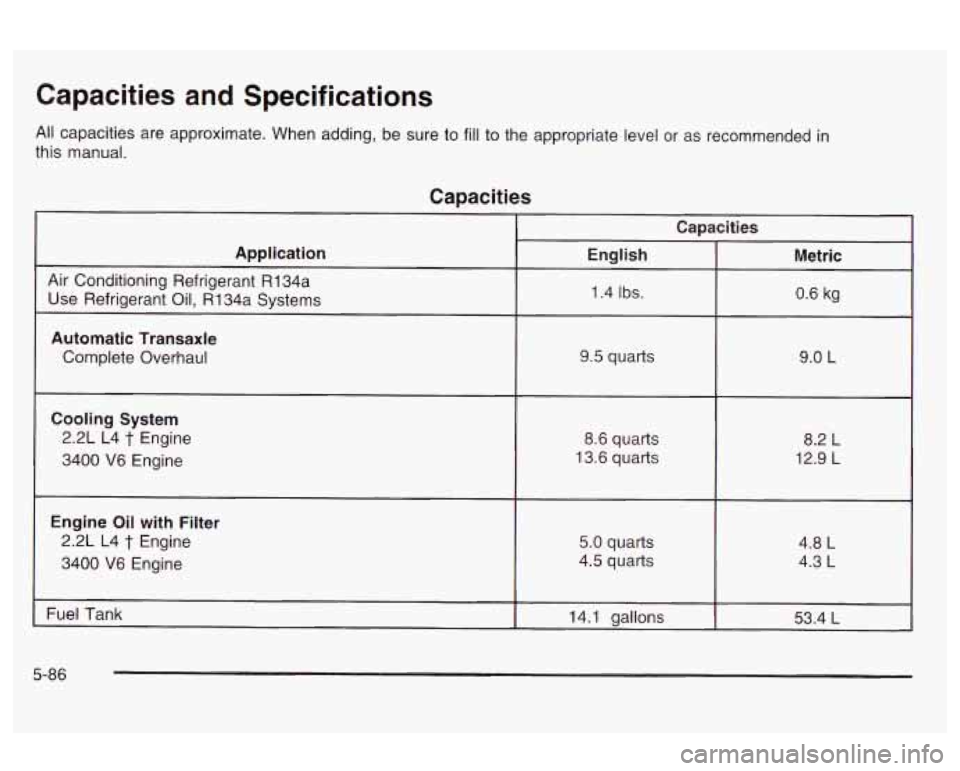
Capacities and Specifications
Capacities
Automatic Transaxle
Complete Overhaul
Cooling System
2.2L L4
t Engine
3400 V6 Engine
Engine Oil with Filter
2.2L L4
t Engine
3400 V6 Engine 8.6
quarts
13.6 quarts 8.2
L
12.9 L 5.0 quarts
4.5 quarts 4.8
L
4.3 L
5-86
Page 303 of 354
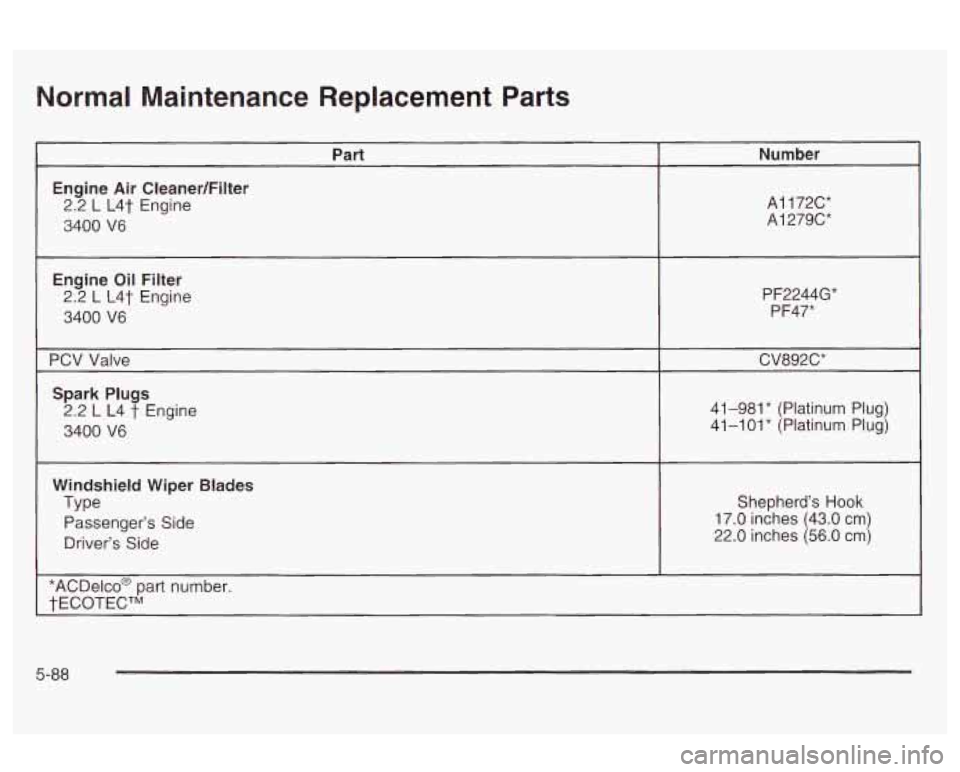
Normal Maintenance Replacement Parts
Part I
Engine Air Cleaner/Filter
2.2 L L4t Engine
3400 V6 Number
AI 172C*
AI 279C"
Engine Oil Filter
2.2
L L4t Engine
3400 V6
PCV Valve Spark Plugs 2.2
L L4 t Engine
3400 V6 PF2244G*
PF47*
CV892C*
41-981
* (Platinum Plug)
41-1
01 * (Platinum Plug)
Windshield Wiper Blades
TY Pe
Passenger's Side
Driver's Side
*ACDelco@
part number.
tECOTECTM Shepherd's
Hook
17.0 inches
(43.0 cm)
22.0 inches (56.0 cm)
5-88
Page 305 of 354

Maintenance Schedule
Introduction
IMPORTANT:
KEEP ENGINE OIL AT THE PROPER
LEVEL AND CHANGE AS RECOMMENDED
14
r
Have you purchased the GM Protection Plan? The Plan
supplements your new vehicle warranties. See your
Warranty and Owner Assistance booklet or your dealer
for details.
Your Vehicle and the Environment
Proper vehicle maintenance not only helps to keep your
vehicle in good working condition, but also helps the
environment. All recommended maintenance procedures
are important. Improper vehicle maintenance can
even affect the quality
of the air we breathe. Improper
fluid levels or the wrong tire inflation can increase
the level of emissions from your vehicle.
To help protect
our environment, and to keep your vehicle in good
condition, please maintain your vehicle properly.
Maintenance Requirements
Maintenance intervals, checks, inspections and
recommended fluids and lubricants as prescribed in this
manual are necessary to keep your vehicle in good
working condition. Any damage caused by failure
to follow recommended maintenance may not be
covered by warranty.
6-2